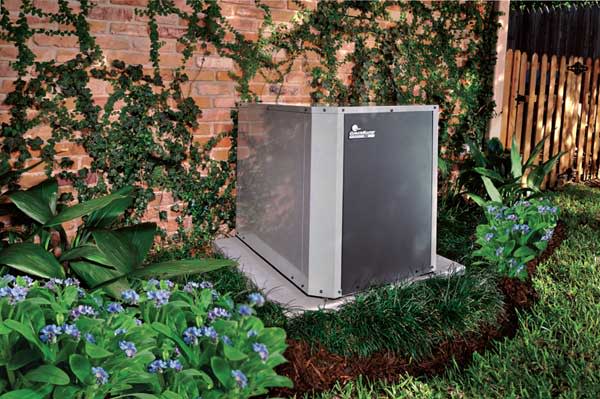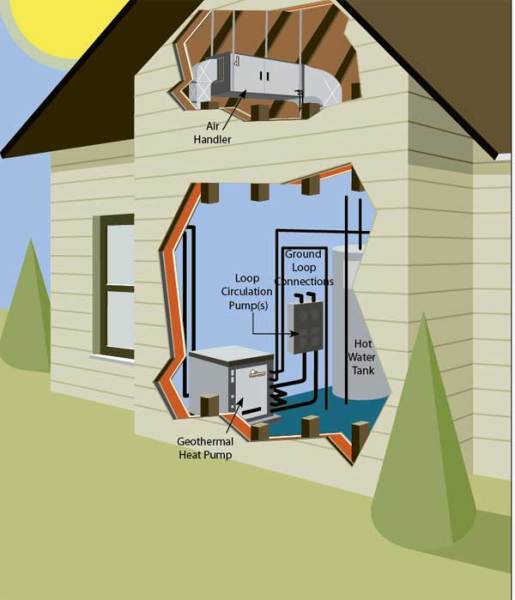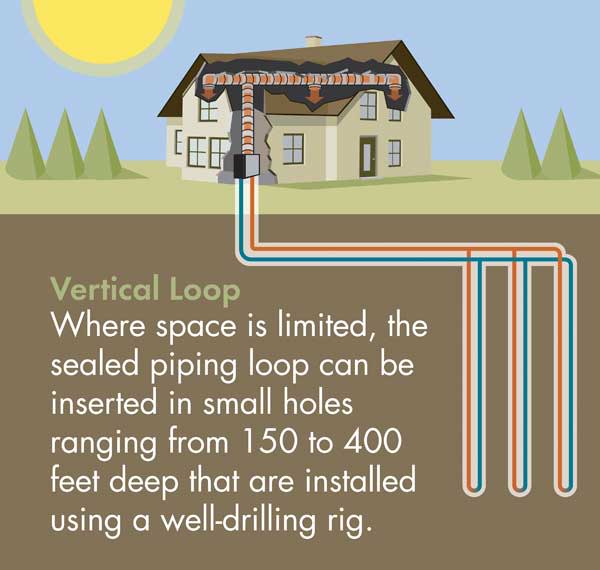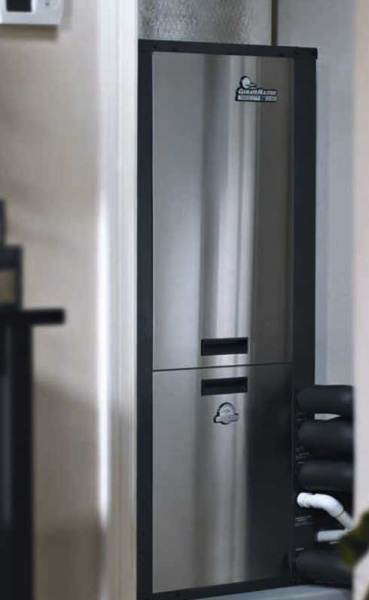
A ClimateMaster outdoor, split-system heat pump, the building’s heating and cooling plant.
Geothermal pertains to the earth’s heat—and harnessing it is nothing new. Until the eruption of Vesuvius in 79 AD, Pompeii was warmed by a sophisticated geothermal heating system. Italy was first to produce geothermal electricity in 1904.
Today, cities from Boise to Reykjavik use geothermally produced electricity. Klamath Falls, Oregon, captures ground heat and pipes it under roads and sidewalks to keep them from freezing in winter.
Geothermal power comes from heat stored in the earth—from the planet’s formation and the radioactive decay of minerals, and, nearer the surface, from the sun. A few feet down, the crust’s temperature is relatively constant at 45 to 58 degrees Fahrenheit, year round. Geo-exchange heat pump systems take advantage of this by circulating water or other liquids through continuous loops of plastic pipes buried in the ground (or a water source like a pond). Those are closed-loop systems; an open-loop option uses well or surface water as the exchange liquid, which is returned to the source.

The cutaway shows how an indoor, split-system pump delivers warmed air and preheats household water.
The fluid collects heat from the soil during winter and carries it through the system to a heat pump in the building, where the heat is compressed to produce more heat that warms air to 90 to 105 degrees, which is moved through the house via standard ductwork. Or it can send heated liquid through an under-floor radiant system.
During summer, a reverse process occurs as circulating fluids transfer heat from the building back into the earth. The very reliable, efficient system provides pleasantly even heat and year-round humidity control, and it’s much quieter than air conditioning.
Ground-source heat pumps also can be used to heat a portion of the hot water supply. In winter, the heat pump reduces water-heating costs by about half. In summer, heat taken out of the house is used to heat the water at great savings.
Pumps are the size of a small refrigerator or furnace and can fit in a closet (no venting is needed). When space is not available, a small, unobtrusive exterior unit such as that from ClimateMaster does the job. Maintenance is simple (e.g., filter changes). Underground pipes are expected to last 50 years and perhaps much longer. Ground-source heat pumps may be added to existing fossil-fuel furnaces to increase their efficiency.

The drawing depicts a closed-loop, liquid-to-air system using vertical loops—deeper but not as space-consuming as horizontal pipes.
Retrofitting an older house for geothermal heating is not complicated, but it may be expensive. The system can be installed in all but the smallest lots, under lawns, driveways, even the house. Pipes can be run horizontally or vertically, depending on the amount of land surface available. Horizontal installation involves laying pipes in trenches four to five feet apart at depths of three to four feet; this trenching will, however, disturb established landscape and tree roots. In space-efficient vertical installations, more expensive and perhaps complicated by the substrate, deep bore holes are drilled 10 to 15 feet apart.

The air handler houses compressor, air coil, blower, filter, and electronic controls; sizes and configurations vary.
Geothermal heat is cleaner than systems that burn fossil fuels on site and is considered easy on the environment. (You won’t be off the grid, though, as electricity is used to run the pumps.) Many states offer tax credits for installation of geothermal systems. A ground-source heat pump can be expected to decrease energy use 25% to 40%, sometimes much more. Upfront cost is high, however; units cost about $2500 per ton of capacity, or $7500 for an average house—almost twice the cost of a conventional system. Drilling can add $10,000 to $30,000. And depending on the particulars of the system, pumps last only about 15 to 25 years. Nevertheless, many homeowners are able to recoup initial installation costs after two or three to seven years. Some experts claim that, in the case of existing homes, it will take 16 to 20 years for a closed-loop system to pay for itself (in lower operating costs).
So. . . is geothermal heating and cooling for you, yes or no? Every site and situation is different. If you are truly interested in switching, consult local experts and installers. General guidelines, given current costs and technologies, look like this:
Do consider a ground-source heat pump if you are building new (or are substantially remodeling and adding space) and you have available land; if your current systems need to be replaced, you have already insulated, etc., yet your energy bills are high, and your property lends itself to trenching or boring; if you are a die-hard believer in going green by example (there’s a Prius in the driveway).
This sort of system is probably not for you if you have working heating and cooling systems in place and are not adding on; if you have little land or are sited on or near ledge (bedrock); if you would need to retrofit ductwork or radiant pipes; if you plan to sell before payback (three to 20 years, depending on installation costs).







